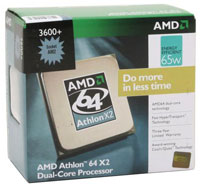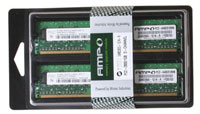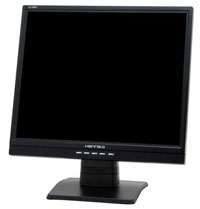Entry Level AMD
The great thing about purchasing a computer right now is that you can get a serious amount of performance for a reasonable price. Our entry level configuration will look to keep price as low as possible without making any major compromises. However, without spending a bit more money it is impossible to purchase a basic computer that will do everything well. The biggest compromise we are making is in the graphics department, where the use of integrated graphics basically means that gaming performance is going to be crippled. For the many people out there that don't care about games, that shouldn't present a problem. It is also relatively simple to upgrade a computer with a discrete graphics card in the future should the need/desire arise.
| AMD Entry Level System |
| Hardware |
Component |
Price |
Rebates |
| Processor |
Athlon 64 X2 3600+ AM2 (Brisbane 1.9GHz 2x512K) - Retail |
$72 |
|
| Motherboard |
ASUS M2A-VM (Socket AM2 AMD 690G) |
$77 |
|
| Memory |
WINTEC AMPO 2x512MB DDR2-800 (5-5-5-12 3AMD2800-1G1K-R) |
$65 |
|
| Hard Drive |
Western Digital Caviar SE16 WD2500KS 250GB 16MB |
$70 |
|
| Optical Drive |
Lite-On 20X DVD+R LH-20A1P-185 |
$34 |
|
| Case |
RAIDMAX APEX ATX-802BP with 450W PSU |
$65 |
|
| Display |
Hanns-G JC-199DPB 19" 8ms (1280x1024) |
$184 |
$40 |
| Speakers |
Cyber Acoustics CA3001WB 14 watts 2.1 Speakers |
$24 |
|
| Keyboard and Mouse |
Microsoft Comfort Curve 2000 B2L-00047 |
$28 |
|
| Operating System |
Windows MCE 2005 or Vista Home Premium (OEM) |
$115 |
|
| Bottom Line |
|
$734 |
$694 |
 |
Prices on AMD's dual core processors are now so low that we see little reason to avoid them. You could shave another $20 off the price by going with a single core Athlon 64 3000+, but that extra $20 buys you potentially twice as much performance. Dual core and multi-core processors are the future, and for those planning to purchase an inexpensive computer and use it for years to come we would just spend the extra money now. The Athlon X2 3600+ (Brisbane core) runs at 1.9GHz and comes with 512K cache per core. Do not confuse this with the 2.0GHz 256K version (Windsor core); the extra cache will almost certainly prove more useful than the extra 100 MHz. For those looking to really cut costs, if you don't want a dual core processor you might as well drop all the way down to the Sempron 64 3000+ (1.6GHz 256K cache) that costs a mere $33. Just don't expect that processor to handle the demands of many applications in three years' time.
 |
Perhaps the most difficult component to get right in any custom-built system is the motherboard. This is particularly true when looking at the budget sector. Buying the least expensive option is rarely the best course of action as features, reliability, stability, and performance can all be compromised. Luckily, the situation is generally better now than it has been in the past, and the integrated memory controller on AMD's processors usually means features and reliability are the only major concerns. For the current cost, the features and performance offered by AMD's 690G chipset put it at the top of our list. Besides a reasonably performing IGP solution - arguably the fastest currently available, though that isn't saying much - you can get VGA, DVI, as well as HDMI video outputs. The ASUS M2A-VM is a micro ATX solution with most of these features, available at a bargain price of only $77. Adding HDMI support will increase the price about $20. It certainly isn't one of the "everything but the kitchen sink" designs, though you can't usually find that without moving beyond the budget sector. This motherboard should also allow at least a moderate amount of overclocking if that's of interest, but that isn't a primary concern here.
 |
We chose DDR2-800 memory, simply because the cost is now at parity with other slower DDR2 memory (i.e. DDR2-667). Memory prices have also become much more reasonable since the beginning of the year, and we're back at the point where 2GB of RAM is available starting at just over $100. We decided not to go that far on entry level configuration, but if you're thinking about running Windows Vista as opposed to Windows XP we would strongly recommend upgrading the memory. On the bright side, at least even micro ATX motherboards are generally offering four DIMM slots these days. For the majority of users, memory timings and overclocking definitely aren't concerns in the budget sector, so we selected an inexpensive Wintec AMPO kit.
For the remaining items, we tried to keep the price down while keeping features and performance as high as possible. We could certainly trim things a bit further (for example getting a 160GB or even 80GB hard drive can save $15-$20), but we prefer to spend slightly more if possible. Getting a less expensive case is something else to consider, and of course those who prefer a little bling have plenty of budget options available. Provided you just want to stay with the basics, you can basically get any cheap case plus power supply and not have any difficulties, but we would still pay attention to user reviews and experiences and do a bit of research first.
 |
The only other major component remaining is the display, and here we were presented with several options. 17" LCDs are the least expensive choice right now, but once you factor in mail-in rebates it really only costs a few dollars more to get a 19" LCD. Some people might actually like the slightly smaller LCD for whatever reason, but we would definitely take a larger LCD first. Looking at the 19" LCDs, you then have to decide between standard aspect ratio and widescreen offerings. We like widescreens for the most part, but it seems like corners are being cut on the panels in order to keep costs down, and actual surface area is slightly larger on a standard aspect ratio display. Hanns G is one of many display manufacturers that most people aren't familiar with, but the reality is that there are only a few actual panel manufacturers. The quality of LCD panels has also reached the point where even the budget offerings look good and perform well. Long-term quality and support is a bit harder to judge, but the average user consensus is that this particular LCD is a very good budget option.














46 Comments
View All Comments
Zepper - Monday, April 23, 2007 - link
You don't have to pay a lot for a decent PSU. The iStar TC-350PD1 is under $40 right now on sale. Even Athenatech has some lower end cases with Fortron/Sparkle PSUs. But you don't act like PSUs are important when testing them separately and then turn around and recommend a junk-bucket even for a budget system..bh.
JarredWalton - Tuesday, April 24, 2007 - link
The case + PSU is $65 shipped. It's actually a pretty decent looking case as well, all told. Now, the iStar costs about $45 shipped at eWiz, which means that you need to find a $20 case that you're happy with or else spend more money. I freely admit that I skimp on PSUs on budget systems, but that's really nothing too surprising. An $80 motherboard with IGP is "skimping", 1GB of RAM is "skimping", etc. They'll all still work fine for most people, but anyone looking to add a GPU, better PSU, etc. quickly vaults into the midrange prices.I supported Dell PCs for several years at another job, and I think they skimp at least as much as anything I've listed here. One year, almost all PCs were fine. Between 12 and 24 months, we had probably 10% fail, many with motherboards and several with PSUs. Past two years, I think the failure rate was approaching 20%, again on mobos and PSUs primarily. I feel a lot worse about cutting costs and quality on a motherboard than I do about going with cheaper PSUs, at least in the budget sector.
JarredWalton - Tuesday, April 24, 2007 - link
Oh, and for that matter I think the LCDs on the low end are suspect as well. I tried to go with ones that are getting favorable ratings, but a lot of people basically seem to say, "Wow - LCDs look cool and it only cost $180! 5 stars!" The thing is, for people that don't go beyond that sort of critique, it probably *is* a five star LCD! That's the same with PSUs and cases. I don't think any serious enthusiast is going to build a decent PC using a budget case and PSU.For the record, the few times I've used Raidmax cases and PSUs (whatever brand they happened to be), I have never had a complaint. Both systems are still running (Athlon XP 2500+) after four years or so. Not bad for a cheap $65 case and PSU. Was I just lucky? Maybe, but that's my experience with budget systems and Raidmax cases. (And also for the record, the people I built those PCs for thought the case looked "l33t" and specifically chose it; I thought it looked gaudy and stupid. No accounting for taste.)
jay401 - Friday, April 20, 2007 - link
That would be the E6320 and E6420. The 50 series doesn't come out until August and will sport higher clockspeeds and higher FSB (1333MHz).
And the question: Any word yet if the Ultra 120 Extreme has been updated to address the concern you guys listed in the review (something about a bracket when trying to mount it on s775 boards)?
Thanks!
redbone75 - Saturday, April 21, 2007 - link
I actually saw the E6320 and E6420 available at Newegg.com on thursday night. Strangely enough they aren't listed there tonight. Both processors are available at zipzoomfly.com, though.jay401 - Friday, April 20, 2007 - link
Dear AMD,This is the final proof you have delayed your R600 GPU series for too long: You didn't even get them out in time for the rarely seen Anandtech Buyer's Guide!
Sincerely,
Disappointed in Delaware
:D